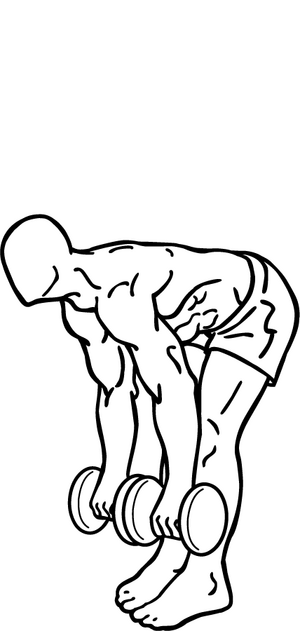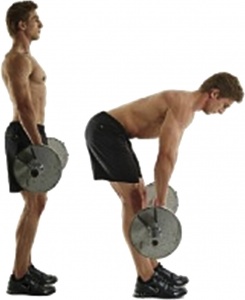Romanian deadlift
Original Editor - Gayatri Jadav Upadhyay
Top Contributors - Gayatri Jadav Upadhyay, Tomer Yona, Lucinda hampton, George Prudden, WikiSysop and Kim Jackson
Introduction[edit | edit source]
A Romanian Deadlift (RDL) is a deadlift in which the body is bent at the hips and the knees are not bent[1]. The deadlift is a strengthening exercise where a loaded barbell is lifted off the ground from a stabilized, bent over position, knees free to bend. It is one of the three canonical powerlifting exercises, along with the squat and bench press.
Posterior Chain Strengthening[edit | edit source]
The RDL is a way to strengthen the erector spinae, multifidus and posterior chain muscles. The Posterior Chain refers to the structures at the back of the leg and spine. The main muscles that make up the Posterior Chain are the calf muscles, hamstrings, gluteus maximi, latissimus dorsi and the erector spinae muscles. When these muscles are strong it results in a decreased risk of both sporting and general injury.[2]
The RDL help in developing movement proficiency in weightlifting as it establishes the correct body positioning through initiation of the posterior chain segment of the hips, buttocks, and hamstrings, a requirement for optimal alignment during lifting.
RDL may be the most challenging lift for athletes to perform correctly, especially in athletes who present with posterior chain segment dysfunction. This is a source of common error because the athlete tries to pull with the lower back, thereby initiating the movement without the hips, buttocks, and hamstrings[3].
Mayer et al [4] highlighted this as a way to exercise and improve lumbar strength.
Indication[edit | edit source]
The RDL/stiff legged deadlift is a popular barbell exercise. It is advocated for strengthening the back extensors. Based on this, many strength and conditioning coaches and personal trainers also recommend this exercise to strengthen the lumbar muscles, supported by the National Strength and Conditioning Association [5].
Researches, using electromyography (EMG), have found activation of the lumbar muscles from RDL. A study in 2010 reported lumbar activation (measured on the lumbar multifidus and the lumbar erector spinae) when considering the RDL; and few studies report lumbar activation (measured on the L3 'paraspinals’) when considering both the sumo and conventional deadlifts.
Since variations deadlift eg RDL have been shown to activate lumbar muscles through EMG, researchers have advocated the use of the Romanian deadlift exercise for strengthening of the back extensors.
Method[edit | edit source]
A comprehensive training session is required to familiarize with the Romanian deadlift and verify the ability of the client to perform it safely.
Teaching components of the RDL:
- Setup. The stance is similar to that of a conventional DL with a double overhand grip. The scapula should be retracted with the spine maintaining its natural s-shaped curvature at the beginning and throughout the entire lift.
- Technique. Movement is achieved via hip flexion during the eccentric phase while maintaining extension in the cervical and lumbar spines, concurrent with holding the knees at approximately 15 degrees of flexion. The bar descends slowly and closely to the thighs instead of being directly underneath the shoulders, reducing the torque on the lumbar spine by placing the load closer to axis of rotation and over the base of support. The bar descends until it is inferior to the knee joint or to the point where the lifter feels the need to flex the back, the urge to further flex the knees, or they have reached their maximal range of motion without compromising lifting posture. Focus is on initiating the movement at the hips, buttocks, and hamstrings while maintaining knee flexion of approximately 15 degrees. When ascending, hip and knee extension should occur simultaneously while maintaining some shoulder retraction and the spine's natural curvature.
- Common Errors Include: A round flexed lower back, excessive kyphosis of the thoracic spine, pulling the bar against the thighs, and excessive extension of the lumbar spine at the end of the lift, not maintaining the 15 degrees knee flexion throughout the lift, extending the knees before hip extension during the ascent[3].
Repetitions: Subject performs a maximal lift with approximately 3 min rest in between to allow for adequate recovery [6]. For the Romanian deadlift 1RM lifting straps are used to ensure the weight is maximal and not limited by the grip strength of the subject.
This exercise could be a valuable addition to many athletes’ strength training regimens, even when performed in low volume and low-frequency (e.g. 1/week).
In application, although the Romanian deadlift can be a valuable exercise, strength coaches should not assume that this will be sufficient exercise for the lumbar extensors as well as for the posterior chain.
Viewing[edit | edit source]
This 6 minute video is titled "Hip Hinging to Deadlifting - designed to help you learn the basics of the hip hinge - to bend at the hips not the back, keep a stable core, protect the spine and the progressions for safe transition into loaded deadlifting correctly"
References[edit | edit source]
- ↑ Your dictionary Romanian Deadlift Available:https://www.yourdictionary.com/romanian-deadlift (accessed 18.2.2022)
- ↑ Melbourne osteopathy Posterior Chain Available:https://www.melbourneosteopathycentre.com.au/blog/training/what-is-the-posterior-chain/ (accessed 18.2.2022)
- ↑ 3.0 3.1 Bird S, Barrington-Higgs B. Exploring the deadlift. Strength & Conditioning Journal. 2010 Apr 1;32(2):46-51.Available: https://journals.lww.com/nsca-scj/Fulltext/2010/04000/Exploring_the_Deadlift.4.aspx(accessed 18.2.2022)
- ↑ Mayer J, Mooney V, Dagenais S. Evidence-informed management of chronic low back pain with lumbar extensor strengthening exercises. The Spine Journal. 2008 Feb 29;8(1):96-113.
- ↑ Baechle TR, Earle RW. Essentials of strength training and conditioning. Human kinetics; 2008.
- ↑ Brown LE, Weir JP. ASEP PROCEDURES RECOMMENDATION I: ACCURATE ASSESSMENT OF MUSCULAR STRENGTH AND POWER. Professionalization of Exercise Physiology. 2001 Nov 1;4(11).








